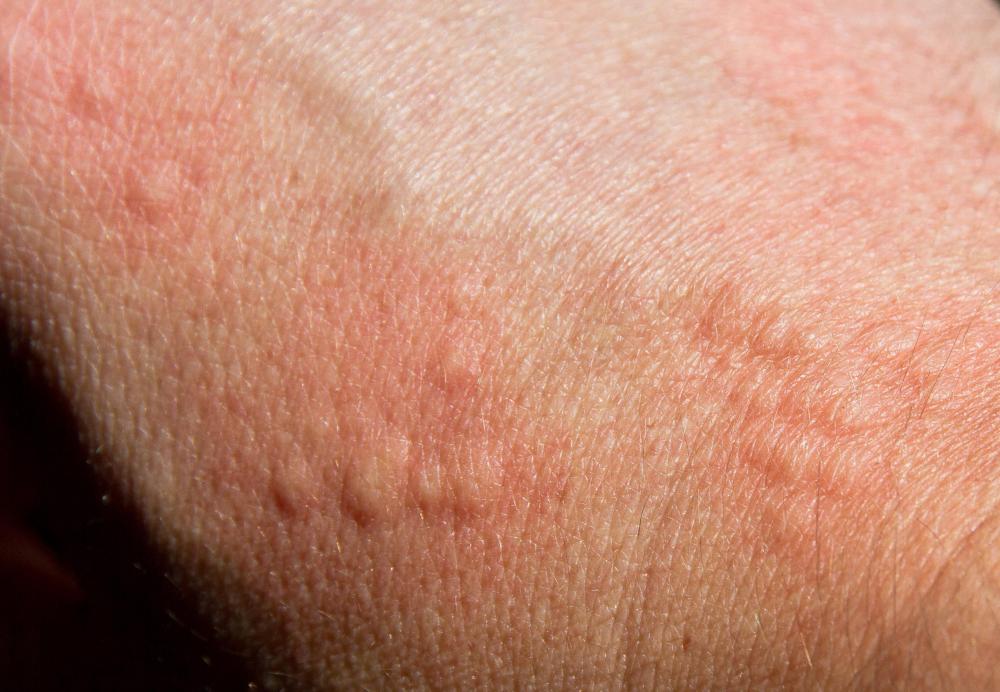At WiseGEEK, we're committed to delivering accurate, trustworthy information. Our expert-authored content is rigorously fact-checked and sourced from credible authorities. Discover how we uphold the highest standards in providing you with reliable knowledge.
What is Formaldehyde Allergy?
A formaldehyde allergy is an allergy to formaldehyde, a chemical which is used in a wide variety of products, from lipstick to particleboard. People with formaldehyde allergies experience adverse reactions when they are exposed to formaldehyde, and these reactions can get worse over time. Treating a formaldehyde allergy is tricky, because the chemical is so commonly used, making it difficult for patients to avoid it.
Individuals with a formaldehyde allergy can experience contact dermatitis from formaldehyde exposure, experiencing rashes, hives, and red, itchy skin. Inhaling formaldehyde fumes or particles of formaldehyde can result in wheezing, shortness of breath, runny nose, headaches, and dizziness. These reactions occur because the body's immune system identifies formaldehyde as something harmful, and goes into overdrive trying to fight it when it enters the body or comes into contact with it.

Many things can cause allergies, making it important to perform proper diagnostic testing before assuming that someone has an allergy. An allergy specialist can conduct a test to determine whether or not someone is allergic to formaldehyde, and to check for reactions to other common allergens. Once an allergy is confirmed as a formaldehyde allergy, the patient can take steps to deal with it. It is a good idea to obtain publications such as pamphlets discussing allergies, so that the patient can leave employers, friends, and family with material to review so that they will more completely understand the patient's situation.

Formaldehyde is used in textiles, building materials, paints, cosmetics, cleaners, and numerous other products. Patients may need to replace a number of things in their own homes to limit formaldehyde exposure, opting for formaldehyde-free products. It's especially important to get rid of formaldehyde-containing clothing, cosmetics, and other things which come into direct contact with the skin. Over time, sources of formaldehyde exposure in the home such as engineering products and paints can also be replaced with formaldehyde-free alternatives.

Patients should be aware that it is effectively impossible to eliminate formaldehyde exposure. People can reduce the incidence of exposure by controlling their home environment and asking for changes in the workplace, but formaldehyde is so ubiquitous that it is difficult to avoid entirely. Patients should plan on keeping a close watch on their health, and talking to a doctor when they develop symptoms of exposure such as hives or difficulty breathing. Medications can be prescribed to help patients control these symptoms of a formaldehyde allergy.
AS FEATURED ON:
AS FEATURED ON:

















Discussion Comments
What is a good hand lotion to use daily when a formaldehyde allergy is suspected?
I've worked for an MDF manufacturer for the past ten years and I have had a horrific sinus condition. I have never been told of the health risk by my employer.
Over the past 12 months I have researched my condition and now believe it to be caused by the MDF dust at work.
I have little to no sense of smell which has made life very flat. It seems that when you lose the sense of smell you lose other bodily functions. My libido dropped dramatically in the first two years.
I cannot sleep in the same bed as my wife because of my nose blocks when I am lying down so I do not get much sleep. I will be starting a you tube blog shortly with the rest.
To help reduce formaldehyde indoors some household plants are very helpful. Plants like philodendron or ferns can keep formaldehyde and other chemicals out of indoors, if not completely eliminate it, they will reduce it.
Post your comments